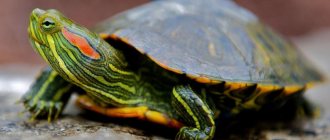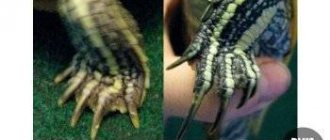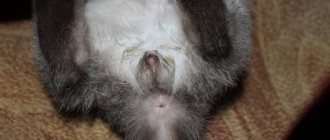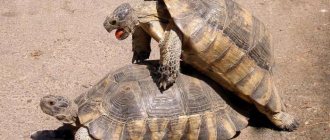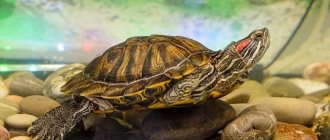- Wild animals
- >>
- Reptiles
Turtles are a fairly large order of reptiles, which includes more than three hundred species. All seas and continents are inhabited by turtles, with the exception of Antarctica, high latitudes and highlands. The land turtle belongs to the animals of the “chordate” type, class “reptiles”, order “turtles” (lat. Testudines). Turtles have existed on Earth for a very long time - more than 220 million years. The animal got its name from the word “testa” - “bricks”, “tiles”. Land turtles are represented by 16 genera, including 57 species.
Origin of the species and description
Photo: Land turtle
Scientists have established that turtles descended from one of the ancient extinct groups of reptiles, the code name of which is the Permian cotylosaurs. The extinct reptiles were very similar in appearance to lizards. They had short, but at the same time very powerful and wide ribs, which over millions of years of evolution turned into a shell. These were sea animals that had a rather long neck and a long tail. The ancestors of turtles were omnivores - they ate both plant and animal foods. Since their remains are now found on all continents, it is generally accepted that Permian cotylosaurs were very common at one time.
Video: Land turtle
The most characteristic feature of all turtles is the presence of a shell, which serves as protection from enemies. It consists of two parts: abdominal and dorsal. The strength of the shell is very high, since it is able to withstand a load that significantly exceeds the weight of the animal - more than 200 times. Depending on the species, land turtles vary significantly in size and weight. Among them there are both giants, weighing almost a ton with a shell size of about 2.5 meters, and very small, even tiny turtles, whose weight is no more than 150 g, and the length of the shell is 8-10 cm.
Zoologists distinguish two suborders of turtles, which differ in the way they hide their heads under their shells:
- side-necked turtles - hide their head in the direction of the left or right paw (sideways);
- Hidden-cervical - fold the neck in the shape of the letter S.
Types of land turtles:
- Galapagos tortoise. Its mass can reach up to half a ton, and its length can reach up to meters. The size and appearance of Galapagos tortoises depend on their habitat conditions. For example, in arid areas their shell is saddle-shaped; in areas where humidity is high, the shell has the shape of a dome;
- Egyptian tortoise. One of the smallest turtles. Lives in the Middle East. The shell size of males is about 12 cm, females are slightly larger;
- panther tortoise. Lives in northern Africa. The length of the shell is about 80 cm, weight is 40-50 kg. The carapace is quite high, dome-shaped;
- speckled cape. The smallest turtle on Earth. Lives in South Africa and Namibia. The length of its shell is no more than 9 cm, and its weight is approximately 96 - 164 g.
How to determine the sex of a red-eared turtle
It is possible to distinguish the sex of red-eared turtles by external characteristics that are present in each individual of this species. The main differences in the gender of animals:
- Differences in shell color.
- Tail type and size.
- The color of a reptile's nose.
- The size of the animal's shell.
- Location of the cloaca.
- Head.
Claw length
The claws on the hind legs are dull in both animals. The male's is longer and sharper.
Males use their claws to secure themselves to their partners' shells during breeding.
This method does not reliably help to find out the sex, because in young reptiles the claws are not fully formed, and a mature animal wears off its manicure on hard ground.
Paws
Male reptiles have femoral spurs on their paws and small scales on their hind limbs.
Features of the shell
To determine the sex of a red-eared slider, look at the ventral part of the shell (plastron). In males it is concave, in females it is not.
The protective element of turtles of different sexes is different. The shell of males is long, in the tail part it forms the Latin letter V. In females, the shell is rounded and large, for bearing eggs. A special hole at the end is for storing.
Males have fewer female companions. There are some exceptions.
In female individuals the color of the plastron is different, in males it is blue.
Tail and cloaca
The most reliable factor in determining gender. In males, the process at the back of the body is long, and the base and tip are wide. Females are characterized by the presence of a short tail uniform in length.
The female's cloaca is located closer to the base of the tail and resembles an asterisk. The reptile's anus is wide for laying eggs. The male's cloaca looks more like a longitudinal line, which is located in the back, closer to the tip of the process.
By behavior
The female has a calm character. She rarely moves unless necessary.
Males, on the contrary, are aggressive. When breeding, they chase the female
They try to attract attention by biting the female on the neck, and also nod often
Other signs
Each type of reptile has a special iris color. Aquatic turtles of different sexes have different eye colors.
The female individual has a yellow nose. For men it is pointed and small.
The male's head is larger with a longitudinal stripe of a reddish hue, which during reproduction takes on a rich, bright color. The upper jaw is whitish in color.
A rare method is a blood test and x-rays. It is pointless to use the method before the age of seven. Males have not yet formed testes, and females have ovaries. Upon reaching puberty, a boy is identified by a blood test that shows elevated levels of testosterone. Ultrasound helps to identify a female individual during the formation of follicles.
- Sex can be recognized after puberty.
- A reliable option would be to make comparisons across multiple animals. Sometimes some signs are similar in turtles of different sexes. It is better to check pets based on several factors.
- Living conditions in animals sometimes cause hormonal imbalance. Then only a veterinarian can determine the sex.
The red-eared turtle is a very cute pet that requires a minimum of attention and care, looks great in photos and delights children with its friendliness. Therefore, owners often try to breed these reptiles by crossing them with each other. The question of determining the sex of the red-eared turtle in this case plays a very important role. However, this task is not at all easy.
, and its solution causes difficulties even for specialists.
The easiest way to do this is to compare two creatures of different sexes
.
This is clearly shown in the video
Then the differences can be seen clearly and the gender of the turtles can be most accurately determined.
Length and shape of claws
Adult males who have reached the age of five have long curved claws, pointed at the ends. While females have short claws and are not sharp at all. If you look carefully through a magnifying glass, you will notice that their ends are rounded.
This sign must be considered in conjunction with the others, since it cannot be considered completely reliable. Some turtles living in a terrarium with hard ground may simply have their claws worn down. In this case, their length and shape will change. And the male can easily be mistaken for a female.
Shell differences
Appearance and features
Photo: Central Asian land turtle
As mentioned earlier, the turtle has a hard and durable shell. The animal has a hard protective shell over the entire surface of its back and belly. The shell itself consists of two parts: the carapace and the plastron. The carapace consists of an internal armor, the basis of which are bone plates, and an outer layer of horny scutes. Some species have a thick layer of skin over their armor. The plastron consists of fused abdominal ribs, sternum and clavicle.
The head of land turtles, in comparison with the body, is not very large in size and has a streamlined shape. This feature allows the animal to quickly remove it in case of danger. The neck of all types of land turtles is quite short, so the eyes are always directed downwards. Animals bite off and grind food using their beaks, which replace their teeth. The surface of the beak is usually rough with characteristic bulges that replace the animal’s teeth.
Interesting fact: Ancient turtles had real teeth, which were reduced over time.
The tongue of turtles is short and never protrudes, since its purpose is to help swallow food. Almost all species of turtles have a tail; it can be with or without a spike at the end. In times of danger, the turtle, like its head, hides it under its shell. Turtles molt periodically, although in land species the molting is not as pronounced as in their marine relatives.
Land turtles can periodically hibernate, which can last up to six months. This happens under unfavorable conditions: frost, drought. Land turtles are very clumsy and slow, for this reason, in case of danger, they do not run away, but hide in their shell. Another method of protection is sudden emptying of the bladder, which, by the way, is very spacious.
3) Central Asian tortoise
(lat.Agrionemys horsfieldii/Testudo horsfieldii) is a yellow-beige turtle with darkening on the shell. The turtle is terrestrial, feeds on vegetation, vegetables and fruits, and lives in the south of Russia and in the countries of Central Asia. The turtle is listed in the Red Book and is prohibited for sale, which is ignored by pet stores and, of course, smugglers. For maintenance you need: terrarium from 100 l + UV lamp 10% UVB + incandescent lamp + soil (sawdust/hay/chips + pebbles) + house.
Where does the land turtle live?
Photo: Land turtle
The habitat of land turtles is concentrated mainly in steppe zones: from Kazakhstan and Uzbekistan to China, as well as in deserts, steppes, savannas, semi-deserts of Africa, America, Albania, Australia, Italy and Greece, Pakistan and India. Turtles are very common in temperate zones and all tropical areas.
You could even say that land turtles can be found almost everywhere:
- in Africa;
- in Central America;
- in South America, except Argentina and Chile;
- in Eurasia, except for the high latitudes of the continent and the Arabian Peninsula;
- in Australia, except New Zealand and the desert central part of the mainland.
The main habitat of land turtles is land, which is quite logical. Occasionally, animals can immerse themselves in water for a short time and do this in order to replenish the loss of moisture in the body.
Turtles themselves dig shelters for themselves, where they stay almost constantly, until hunger forces them to go hunting. For this reason, reptiles prefer to live on loose sandy and loamy soils, covered with dense vegetation, where there is sufficient water and food. Turtles prefer loose soil because it is much easier to dig.
Diet
Leatherback turtles feed on poisonous jellyfish. As a result, the meat of the creatures becomes unsuitable for food.
The diet of the marsh turtle is slightly different. The diet of this type of turtle includes amphibians, snails, worms, and insects. The sharp claws of this animal help it tear apart its prey. Sometimes such a turtle also eats fish.
Read also: Interesting facts about gyrfalcons, habitat, species, nutrition, reproduction
Marine and freshwater turtles are true predators because their diet includes various types of small fish, frogs, snails and crustaceans.
What does a land turtle eat?
Photo: Large land turtle
The basis of nutrition for land turtles is plants, that is, plant foods: grass, young branches of bushes and trees, juicy fruits, berries, fruits, vegetables. Sometimes, to maintain protein balance, they can feast on animal food: snails, slugs, worms and small insects.
Turtles obtain moisture for the body mainly from the succulent parts of plants, but if necessary, they can also drink water, doing this at any opportunity. Box turtles eat lichens and mushrooms, including poisonous ones. Because of this feature, their meat also becomes poisonous and is not suitable for food. But this is for the better, because the meat of most turtle species is considered a delicacy, which is why their numbers are constantly decreasing.
Central Asian turtles sit in their shelter all day, and only come out to eat after dark. This species is the most popular among turtle lovers as pets because they eat almost anything. During the winter, turtles do not eat anything because they hibernate. This behavior is due to the fact that with the onset of cold weather, food becomes very scarce. The duration of hibernation for land turtles depends on the climate. In the wild it lasts from October to March.
Now you know what to feed a land turtle at home. Let's see how she lives in the wild.
Diseases of the red-eared turtle
Preferring warmth, red-eared turtles contract diseases mainly associated with temperature changes. So, pets can get pneumonia. Like pneumonia in people, it can be one- or two-sided. The latter often leads to death.
You can diagnose pneumonia in a turtle yourself. The animal becomes lethargic and loses the ability to dive, although it tries to go under water. The treatment is to hold your pet over a hot chamomile decoction. The reptile must inhale the vapors. To prevent the turtle from being burned, we check the temperature of the steam at a selected distance from the cup with our hand.
When treating pneumonia in a turtle, it is important to eliminate sources of cold in its familiar environment. For some reason the animal got sick
Usually, the water in the terrarium is supercooled. Although red-eared turtles spend most of their time in the water, there are illnesses that require shellfish to be kept on land.
This applies to conjunctivitis. Red-eared cats are predisposed to it. The disease is contagious. Therefore, an individual with conjunctivitis is separated from the rest and allowed into the water only for a couple of hours a day.
Drug treatment for eye inflammation in red-eared turtles comes down to instilling an antibiotic. Human ones are suitable, for example, Diclofenac. The red-eared turtle will “open” its eyes in 3-4 days. If you start treatment at the first symptoms, a couple of days of therapy is enough.
Rickets is the 3rd typical disease of the red-eared slider. The animal's skull and other bones do not soften. The “impact” falls on the shell. By throwing calcium reserves onto the main skeleton, the body limits the supply of its “house”.
A deficiency of building material is caused by a lack of ultraviolet radiation, that is, sunlight and poor nutrition. For example, a meat diet leads to rickets. Red-eared turtles are omnivores and need not only proteins, but also fiber, fats, and carbohydrates.
An incorrect diet also provokes the development of skin diseases in red-eared turtles. The covers begin to peel off. These are symptoms of a lack of vitamins A and B. Therapy consists of eating foods rich in them. However, in order not to overdo it and provoke hypervitaminosis instead of vitamin deficiency, it is recommended to use balanced supplements from pet stores.
Features of character and lifestyle
Photo: Land turtle in nature
Even though the development of the brain in turtles is not at a high level, they have considerable intelligence. Land turtles are solitary reptiles. Their herd instinct is not developed at all. They look for a mate exclusively for the mating period, after which they safely leave the partner.
Also, all turtles are characterized by slowness, which is characteristic of most reptiles. In addition, turtles, like bears, under unfavorable conditions (during the winter months) can hibernate, for which small groups occasionally gather. During hibernation, all vital processes in their bodies slow down, which allows them to easily endure the winter cold. Turtles are also long-lived, even by human standards, as they can live many times longer than humans. On average, the life expectancy of land turtles in nature is 50-150 years.
Interesting fact: The oldest turtle in the world today is a tortoise named Jonathan. She lives on the island of St. Helena and probably remembers the times of Napoleon, when the former French monarch lived there in exile.
There are very few known cases of turtles causing harm to humans. Only snapping turtles became famous for this, and then only during the mating period, when the male can mistake a person for a rival and attack him.
Hibernation of the red-eared turtle
The red-eared turtle lives in warm areas. The animal is comfortable at +35-42 degrees Celsius. Such conditions of keeping the red-eared turtle do not force it to hibernate. Simply put, prolonged sleep is a sign of an unfavorable environment for a species.
Temperatures below 10 degrees are critical. The usual room temperature for Russians does not suit pets either. We need terrariums for red-eared turtles. Only in them, under bright, warm lamps, do animals feel at ease.
If a terrarium individual hibernates, a disease is suspected. We will talk about typical ailments for red-eared turtles in a separate chapter. In the meantime, let’s take into account the possibility of improper organization of pets’ lives in the terrarium.
Firstly, turtles of the species love space. The aquarium should be low but wide. Secondly, it is difficult to determine the heating of the water. Need a thermostat. In general, we study the chapter “Secrets of caring for the red-eared turtle.”
Social structure and reproduction
Photo: Baby land turtle
As such, there is no mating season for turtles, so reproduction occurs at different times depending on the species and location. In land turtles, the onset of mating games is signaled by one event: for the right to fertilize a female, males enter into battle with each other. In doing so, they try to turn their opponent over or force him to retreat. There is only one method of action - powerful frequent strikes with the shell on the opponent's shell.
After the shameful flight of the competitor from the battlefield, the victorious male begins courtship. To attract the attention of the female, the winner can affectionately stroke her head with his paws and even sing. Some time after mating, the female lays eggs. To do this, they dig holes in the sand near bodies of water. Often, their own holes or even crocodile nests are used for these purposes. The egg clutch is thoroughly covered with sand or soil and compacted using a shell.
The number of eggs in a clutch may vary, depending on the type - 100-200 pieces. The eggs themselves can also be different: covered with a shell or a dense leathery shell. During the mating season, the female may lay several clutches. Under favorable conditions, after 91 days, small turtles hatch from the eggs, and their sex completely depends on the temperature at which the incubation period took place. If it was cool, then males would hatch, if it was hot, then females. For reasons unknown to science, sometimes the incubation period can stretch from six months to several years.
Interesting fact: In 2013, an amazing event occurred in the museum of the city of Dnepr (formerly Dnepropetrovsk). Turtle eggs, which had been lying on exhibit stands for several years, unexpectedly hatched into baby turtles.
Types of small
According to the scientific classification, small turtles are considered freshwater species, the average size of which does not exceed 13 cm. A terrarium with a capacity of 100 liters is suitable for pets.
Three-keel
Small reptiles up to 13 cm. Color from reddish-brown to black, carapace with three keels. Easy to care for, an aquarium up to 100 liters is suitable. They inhabit the countries of South Asia and lead a completely land-based lifestyle in forests. They are omnivores, eat fruits and vegetables, and are not averse to eating fish. In some countries they are prohibited for home keeping.
Natural enemies of land turtles
Photo: Land turtle
Despite reliable protection in the form of a hard shell, turtles have many enemies in nature. Birds of prey (hawks, eagles) hunt them and drop them from a height onto rocks, pecking out their entrails. Crows, magpies, and jackdaws can completely eat barely hatched babies. There have been cases when foxes threw turtles from cliffs onto stones in order to then split their shells and eat them.
In South America, land turtles are hunted very successfully by jaguars. They eat reptiles out of their shells so skillfully that the results of their work can be compared to the activity of a surgeon’s scalpel. At the same time, predators are not content with one turtle, but eat several at once, turning them over on their backs with their paws on flat ground, without grass and stones. Sometimes large rodents, rats, prey on turtles, biting off their tail or limbs. At the same time, the most important enemies of turtles are people who hunt them for eggs, meat, and just for fun.
In addition to predators and humans, the enemies of turtles can be fungi, viruses, and parasites. Often, sick and weak turtles, due to their slowness, become food for ants, which can very quickly gnaw off the soft parts of the body. Some turtles can even engage in cannibalism, eating their relatives if they are unable to escape or resist. As for the giant Galapagos tortoises, given their size and weight, they have no natural enemies.
Interesting fact: Aeschylus, the ancient Greek playwright, died a very ridiculous death. A turtle, picked up by an eagle, fell on his head.
Population and species status
Photo: Land turtle in nature
Only 228 species of turtles have protected status from the International Union for Conservation of Nature, and 135 of them are on the verge of extinction. The most famous rare endangered species of land turtles is the Central Asian land turtle.
The main reasons that threaten the growth of the population of land turtles:
- poaching;
- agricultural activities;
- construction activities.
In addition, land turtles are very popular pets, which also does not work in their favor. After all, for this purpose, turtles are constantly caught and kept in captivity until sold, and not always in good conditions.
Turtle meat is a valuable delicacy, which is why it is popular among restaurateurs. The unpretentiousness of turtles greatly facilitates their transportation, which is why they are transported as “live canned food.” Animal shells are often used in the manufacture of various souvenirs and traditional women's hair jewelry.
Fun fact: In most states in the United States, keeping turtles as pets is legal, but not recommended. However, it is completely prohibited in Oregon. In addition, US federal law prohibits turtle racing, as well as the trade and transportation of turtles smaller than 10 cm.
Identifying the species of domestic turtle
The following types of turtles are most often kept in the homes of animal lovers in the CIS: freshwater red-eared turtle, freshwater marsh turtle, freshwater turtle Trionics and land Central Asian turtle. In the south and east of Russia and Ukraine live: marsh turtle, Caspian turtle, Far Eastern trionics, Central Asian turtle. Red-eared turtles are brought in large numbers from America or nurseries in Europe.
The four most popular types of turtles are listed below:

